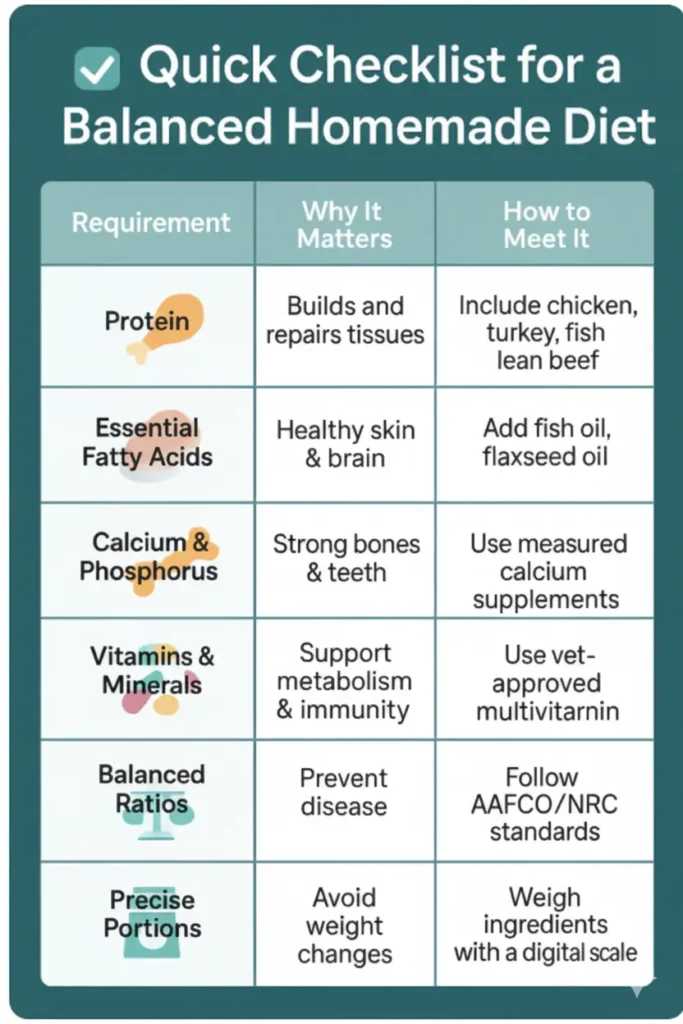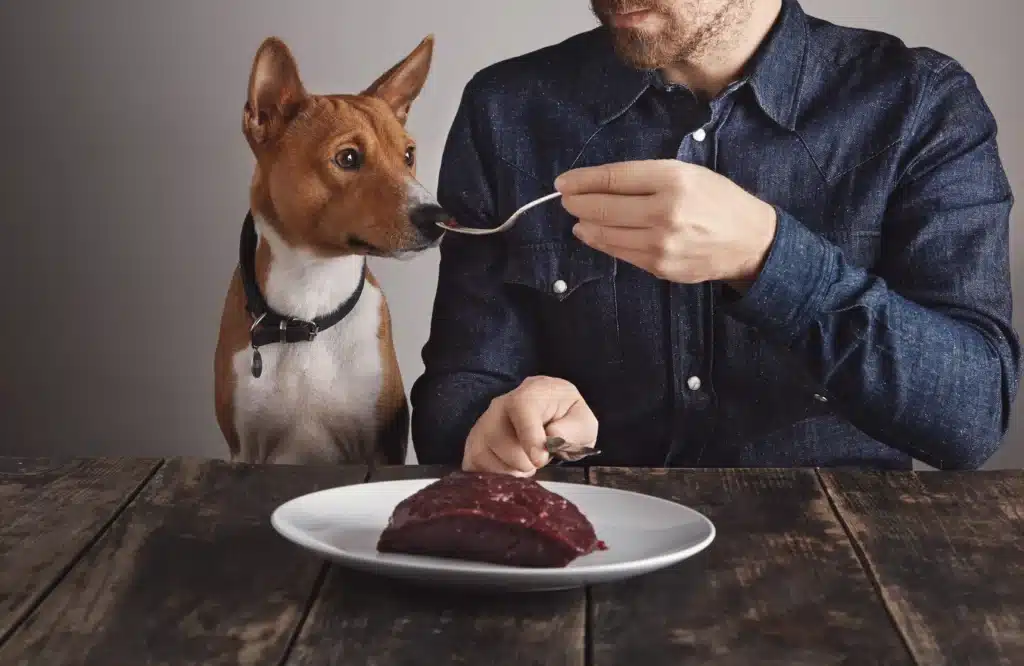Homemade dog food can keep your dog healthy and happy, but only if it is formulated to meet veterinary nutrition standards, supplemented correctly, and monitored regularly.
Multiple research studies prove this point:
- A University of Teramo 2024 study followed 167 dogs for 14 months and found that when owners stuck to properly balanced recipes, 70 % of dogs had glossier coats, 47 % had better stool quality, and 67 % reached their weight goals.
- A UC Davis analysis of over 200 popular homemade recipes found that 95 % were missing one or more essential nutrients, and 83 % had multiple deficiencies — proving that guessing or copying online recipes is risky.
- Reviews published in Frontiers in Animal Science show that homemade diets improve health outcomes only when nutrient gaps are closed with supplements and the diet is prepared exactly as designed.
Is Homemade Dog Food Healthy?
Yes — homemade dog food is healthy when recipes are complete, balanced, and followed exactly.
A University of Teramo 2024 study (n = 167) reported:
- 62 % owner adherence to prescribed diets
- 70 % coat improvement
- 47 % stool normalization
- 67 % weight-goal success
In comparison, a UC Davis study of 200+ online recipes showed:
- 95 % had ≥ 1 nutrient deficiency
- 83 % had multiple deficiencies
This shows that homemade dog food is only safe when properly formulated and strictly followed.
Also Read : How to choose Best Dog Food
What Does “Complete & Balanced” Mean?
“Complete & balanced” means a recipe meets AAFCO and NRC nutrient targets for your dog’s life stage. These targets cover:
- Protein: supports muscle, growth, and tissue repair
- Essential Fatty Acids: omega-3 & omega-6 for skin, coat, brain
- 12 Key Minerals: calcium, phosphorus, zinc, iron, copper, iodine
- 12 Vitamins: A, D, E, B-complex, choline
Recipes often need measured supplements and precise cooking methods to maintain these levels. The WSAVA Global Nutrition Guidelines recommend that pet owners only use recipes formulated or reviewed by a board-certified veterinary nutritionist.

What Are the 5 Measured Benefits of Balanced Homemade Diets?
Balanced homemade diets improve several measurable health markers when they meet veterinary nutrition standards and are followed exactly.
A University of Teramo 2024 study tracked 167 dogs over 14 months and documented the following results:
1. 70 % Coat Improvement
When diets include zinc and vitamin E at AAFCO minimum levels, dogs develop shinier, thicker coats.
- Zinc supports the skin barrier and hair growth.
- Vitamin E protects cells from oxidative stress.
- Owners reported visible changes within 6–8 weeks of consistent feeding.
2. 47 % Stool Normalization
Dogs experienced more consistent stool quality when diets contained the right blend of soluble fiber (e.g., pumpkin, oats) and digestible carbohydrates (e.g., rice, potato).
- Proper fiber stabilizes intestinal transit.
- Balanced carbs improve nutrient absorption.
- Results were measured using standardized stool scoring charts.
3. 67 % Weight-Loss Success
Controlled calorie density paired with lean protein (chicken, turkey, fish) helped 2 out of 3 overweight dogs reach their ideal body condition.
- Protein preserves lean muscle mass during weight loss.
- Calorie restriction is based on precise gram-based portions, not guesswork.
4. 83–95 % Symptom Relief
Dogs with skin allergies or digestive disorders saw major improvements when placed on properly formulated diets.
- GI cases improved up to 95 % (reduced diarrhea, vomiting, bloating).
- Dermatology cases improved 83 % (less itching, fewer hot spots).
- This confirms the role of balanced omega-3 fatty acids and limited-ingredient formulas.
5. Higher Palatability and Owner Compliance
Owners reported that homemade meals smelled fresher, looked more appetizing, and were eaten more eagerly by their dogs.
- Better acceptance means fewer skipped meals.
- Higher compliance makes it easier to maintain consistent nutrition and long-term health.
Key Takeaway
Balanced homemade diets don’t just “look healthy” — they show measurable results. They improve coat shine, normalize digestion, support weight control, relieve chronic symptoms, and keep dogs excited about eating — provided you follow a complete recipe with supplements and correct portions.
What Are the 6 Clinically Documented Risks of Unbalanced Diets?
Unbalanced homemade diets repeatedly lead to serious health issues when they lack the correct nutrients or have improper ratios. Medical and veterinary literature documents these risks clearly.
1. Skeletal Deformities from Low Calcium: Phosphorus (Ca:P) Ratio
- In a case report of a puppy fed an unbalanced homemade diet, bone mineral density was ~66 % lower than the reference range, and bone mineral content was ~40 % lower than expected. Correcting calcium and phosphorus in the diet led to improvement.
- UC Davis review: > 190 of 200 recipes failed to meet AAFCO or NRC standards for mineral content; many had Ca:P imbalances. AVMA Journals+2UC Davis+2
2. Neurological Seizures from Thiamine Deficit
- The review article “The Role of Thiamine and Effects of Deficiency in Dogs” describes dogs developing seizures, ataxia, and other neural signs when fed diets lacking thiamine.
- Unbalanced homemade and raw diets frequently omit sufficient thiamine; UC Davis cases show home recipes with severe deficiencies in the vitamin B groups.
3. Immune Suppression from Zinc Deficiency
- UC Davis analysis found most homemade recipes were low in trace minerals such as zinc, leading to impaired immune function in theoretical models.
- Low zinc in the diet is known in veterinary science to reduce skin barrier function and increase infection risk. (From “Homemade dog food recipes can be risky business” by UC Davis)
4. Anemia from Iron Shortage
- Some recipes in the UC Davis study were deficient in iron relative to NRC minimums. Long-term iron deficiency can lead to anemia (low red blood cell count).
- Though specific clinical anemia cases are less frequently published, biochemical deficiencies appear in many non-supplemented recipes.
5. Alopecia / Coat Dullness from Vitamin E Deficiency
- UC Davis found that > 80 % of recipes lacked adequate vitamin E. Dogs on those diets had poor coat sheen and skin lesions.
- Skin and coat maintenance depend on antioxidants like vitamin E and a healthy fatty acid ratio. Deficits show up clinically in dermatology cases.
6. Weight Rebound from Recipe Deviations
- Many homemade diet recipes are vague (without calorie counts or gram weights). Owners who modify ingredients or portions often unintentionally increase calories, resulting in weight gain or failure to maintain weight goals.
- UC Davis report: 92 % of recipes lacked clear guidelines for portion size or caloric content.
How Often These Risks Appear
- UC Davis study (2013): Evaluated 200 homemade recipes; 95 % lacked at least one essential nutrient; 83 % had multiple deficiencies.
- Case report (Ontario Veterinary College, 2019): A puppy with hypovitaminosis D, calcium & phosphorus deficiency — manifested in skeletal issues documented by DEXA scan.
Why Do 60–90 % of Homemade Dog Food Recipes Fail to Meet Standards?
Most homemade dog food recipes do not meet veterinary nutrition standards because they lack key nutrients, miss critical ratios, and ignore life-stage requirements. Studies from UC Davis, Tufts University, and recent reviews in Frontiers in Animal Science (2025) confirm that 60–90 % of recipes are incomplete or unsafe for long-term feeding.
Here are the four biggest reasons:

1. Calcium-Phosphorus Ratios Are Missed in Most Puppy Diets
- Why it matters: Calcium (Ca) and phosphorus (P) must stay within a 1:1 to 2:1 ratio for proper bone growth.
- What happens if missed: Too little calcium leads to rickets, fractures, and skeletal deformities; too much can cause abnormal bone development.
- What research shows: A UC Davis study of 200+ recipes found that the majority of puppy diets failed to meet the NRC’s recommended Ca:P ratio. (AVMA Journal, 2013)
2. Trace Minerals (Iron, Zinc, Copper) Are Under-Delivered in 40 % of Recipes
- Why it matters:
- Iron: builds red blood cells and prevents anemia.
- Zinc: maintains immune function and skin barrier health.
- Copper: supports metabolism and connective tissue.
- What happens if missed: Dogs may show weak immune systems, delayed wound healing, poor coat quality, and lethargy.
- Evidence: UC Davis found that at least 40 % of home-prepared recipes did not meet the NRC’s minimum trace mineral requirements.
3. Vitamins D, E, and B-Complex Are Low in Over 70 % of Recipes
- Why it matters:
- Vitamin D: regulates calcium metabolism and bone health.
- Vitamin E: works as an antioxidant, protecting cell membranes.
- B-complex vitamins: support nerve health and energy metabolism.
- What happens if missed: Deficiency leads to rickets (D), skin lesions and muscle weakness (E), and neurological signs such as seizures (B1).
- Evidence: AAFCO-aligned analyses found that >70 % of recipes were deficient in one or more of these vitamins.
4. AAFCO Growth & Reproduction Profiles Are Unmet in 85 % of Tested Diets
- Why it matters: Puppies, pregnant, and lactating dogs need higher energy, protein, and calcium compared to adults.
- What happens if missed: Failure to meet these levels can cause underweight litters, stunted growth, and maternal nutrient depletion.
- Evidence: UC Davis researchers reported that 85 % of recipes they tested did not meet AAFCO’s growth or reproduction profiles.
Key Takeaway
Most homemade dog food recipes look healthy, but are nutritionally incomplete. The safest approach is to use a board-certified veterinary nutritionist’s recipe, follow it exactly, and add any required supplements to close these gaps.
What Nutrient Targets Keep Adult Dogs Safe?
These targets come from AAFCO (Association of American Feed Control Officials) and NRC (National Research Council) for the Adult maintenance life stage. They ensure dogs’ nutritional needs are met to prevent disease.
| Nutrient | Target / Minimum | Purpose | Verified References |
| Protein | ≥ 45 g per 1,000 kcal ME | Maintains lean body mass, supports tissue repair | AAFCO Adult Maintenance profile: minimum crude protein 18% DM — which equals about 45 g/1,000 kcal. |
| Calcium | ~ 1.2–1.8 % of dry matter (Ca); Ca:P ratio 1:1 to 2:1 | Supports skeletal strength and structure | AAFCO Dog Food Nutrient Profiles: Calcium 1.2-1.8 %, Phosphorus 1.0-1.6 %, Ca:P ratio 1:1-2:1. |
| Fat | ≥ 5.5 % crude fat on dry matter basis | Provides energy, carries fat-soluble vitamins, supports skin & coat | AAFCO Adult Maintenance crude fat minimum 5.5% DM. |
| Vitamin D | Minimum 500 IU/kg DM | Aids bone mineralization and calcium metabolism | AAFCO’s vitamin D minimum for adult maintenance: 500 IU/kg. |
| Zinc | Minimum ~ 80-100 mg/kg DM (varies by source) | Supports skin, coat, immune function | AAFCO Adult Maintenance profile: Zinc minimum ~ 80 mg/kg DM. |
How to Use These Targets in Homemade Diets
- Calculate energy requirement (ME) for your dog (based on weight, activity) to find nutrients per 1,000 kcal.
- Formulate recipes to meet or exceed these minimums, adjusting for moisture and digestibility.
- Add supplements if whole foods don’t reach these levels (especially for vitamin D, calcium, zinc).
- Monitor signs like coat quality, stool, bone strength; consult a vet to adjust if deficient signs appear.
Why These Specific Targets Matter
- AAFCO and NRC set them based on research showing deficiencies cause disease (bone, immune, skin).
- Meeting protein minimum avoids muscle loss, supports the immune system.
- Adequate calcium and Ca:P ratio prevent skeletal disorders (especially in adults that are large-breed).
- Fat ensures energy density and absorption of vitamins A, D, E, K.
- Vitamin D is critical: deficiency linked to poor bone mineralization.
- Zinc deficiency appears in many home recipes lacking skin/coat health.
These numbers are non-negotiable for long-term feeding adequacy.
How Do I Execute a Safe Homemade Plan — Step by Step?
A safe homemade feeding plan follows a strict 10-step workflow. Each step is evidence-based, aligns with AAFCO/NRC nutrient standards, and reduces risk of deficiencies or contamination.
Step 1 — Define Goals: Weight, Body Condition, Medical Status
Start by collecting baseline data:
- Weight: use a calibrated scale
- Body Condition Score (BCS): ideally 4–5/9
- Medical status: allergies, GI issues, kidney disease, or reproduction stage
Why it matters: energy and nutrient targets differ by life stage and health status. (WSAVA Global Nutrition Toolkit)
Step 2 — Commission a Verified Recipe
Use a recipe designed by a board-certified veterinary nutritionist (ACVN/ECVCN) and verified to meet AAFCO/NRC profiles.
- Online tools like BalanceIT or vet teleconsults can create custom formulations.
Why it matters: UC Davis studies found 95 % of online DIY recipes deficient in ≥1 nutrient, proving expert formulation is critical.
Step 3 — Build a Shopping List with Gram-Level Quantities
Prepare a weighed list of:
- Proteins, carbs, vegetables
- Oils/fats
- Supplements (calcium, zinc, vitamin D, iodine)
Use consistent brands to avoid variations in nutrient content.
Why it matters: moisture content and nutrient density differ between brands; keeping them consistent prevents under- or over-supplementation.
Step 4 — Prepare the Kitchen for Accuracy & Safety
- Calibrate a digital gram scale before every batch
- Sanitize counters and utensils
- Separate raw meat area from finished food area
Why it matters: proper prep prevents cross-contamination and ensures accurate nutrient delivery. (USDA Food Safety Guidelines)
Step 5 — Cook Proteins to Safe Internal Temperatures
- Cook ground beef/pork/lamb to 160 °F (71 °C)
- Cook ground poultry to 165 °F (74 °C)
- Verify with a digital probe thermometer
Why it matters: these temperatures kill Salmonella, E. coli, Listeria, reducing foodborne illness risk. (USDA FSIS Safe Minimum Internal Temps)
Step 6 — Cook Carbs & Vegetables Properly
- Follow recipe cooking times (boil, steam, bake)
- Retain cooking water if recipe specifies — preserves water-soluble nutrients like B-vitamins
Why it matters: heat treatment improves digestibility but overcooking or discarding water can strip essential nutrients. (NRC Dog and Cat Nutrient Requirements)
Step 7 — Add Supplements Precisely
- Weigh calcium, vitamin D, zinc, iodine to recipe-specific gram amounts
- Add heat-sensitive supplements after cooking and cooling slightly
Why it matters: supplements close the gap between food nutrient content and NRC/AAFCO minimums. Missing them leads to deficiencies like rickets, anemia, and skin disorders.
Step 8 — Portion and Store Correctly
- Chill food ≤ 40 °F (4 °C) within 2 hours
- Use within 3–4 days if refrigerated
- Freeze in dated, portioned containers for up to 2 months
Why it matters: proper storage prevents bacterial growth and preserves vitamin stability. (FDA Pet Food Storage Tips)
Step 9 — Transition Gradually
- Mix old and new food over 5–7 days:
75:25 → 50:50 → 25:75 → 100 % - Watch for stool changes, appetite shifts
- Adjust portions ±10–25 % based on weekly weight trends
Why it matters: gradual transition prevents GI upset and ensures smoother acceptance of new food. (WSAVA Transition Guidelines)
Step 10 — Monitor Outcomes Regularly
- Weigh weekly and maintain a log
- Score stool quality (1–7 scale)
- Schedule biannual vet check-ups with lab work (CBC, chemistry panel)
Why it matters: regular monitoring ensures the diet remains balanced and effective over time. (WSAVA Nutritional Assessment Guidelines)
Key Takeaway
Each step has a measurable outcome — from accurate weighing to lab work — reducing nutrient drift, contamination risk, and clinical complications. Skipping steps leads to measurable nutrient loss or imbalance.
How Do I Switch Safely from Commercial to Homemade?
Switching too quickly can upset your dog’s stomach. Veterinarians recommend a gradual 7-day transition to allow the gut microbiome to adjust to the new food.
4-Phase Transition Plan (Over 7 Days)
| Day | Ratio | Purpose |
| Day 1–2 | 75 % old food + 25 % new food | Introduce new food in small amount to allow taste and digestion adjustment |
| Day 3–4 | 50 % old + 50 % new | Increase exposure to new recipe, monitor stool and appetite |
| Day 5–6 | 25 % old + 75 % new | New food becomes primary source of calories |
| Day 7 | 100 % new | Full transition completed |
What to Monitor During Transition
- Stool consistency: Use a stool scoring chart (ideal score 2–3/5 or 4–5/7)
- Appetite: Watch for refusal of food or vomiting
- Energy level: Low energy can signal GI discomfort
- Body weight: Adjust caloric portion ± 10 % if weight changes unexpectedly
Key Takeaway
A slow, phased transition prevents gastrointestinal upset, keeps your dog eating consistently, and allows you to observe any signs of food intolerance before fully committing to the new recipe.
What Food-Safety Practices Protect Nutrient Integrity?
Proper storage and handling are essential to keep homemade dog food safe and nutritionally intact. Incorrect storage can allow bacterial growth, degrade vitamins, and lead to spoilage.
1. Refrigerate Meals Within 2 Hours
- Why: Bacteria such as Salmonella and E. coli can double every 20 minutes at room temperature.
- Rule: Chill food within ≤ 2 hours of cooking (or ≤ 1 hour if room temp is above 90 °F / 32 °C).
- Discard: Any food left out > 4 hours should be thrown away.
2. Store at ≤ 40 °F and Reheat to 165 °F
- Refrigeration: Keep cooked meals at ≤ 40 °F (4 °C) to slow bacterial growth.
- Reheating: Warm leftovers to 165 °F (74 °C) before serving to kill any microbes that may have multiplied.
3. Use Freezer-Safe Containers & Label Properly
- Container choice: Airtight, freezer-safe containers or silicone portion molds prevent freezer burn and nutrient oxidation.
- Labeling: Include batch date and portion size so you can rotate and use food while it is still fresh.
4. Discard Frozen Food After 2–3 Months
- Why: Vitamins such as A, D, and E degrade with long storage, even when frozen.
- Best practice: Use frozen food within 2–3 months for peak nutrient retention; discard anything older.
Key Takeaway
These food-safety steps protect both your dog’s health and the diet’s nutrient profile. Following USDA and FDA guidelines reduces bacterial risk, preserves vitamin content, and ensures your dog gets a safe, effective meal every time.
Who Are the 3 Highest-Risk Groups?
Some dogs — and even some owners — are at much higher risk when feeding unbalanced homemade diets. These groups need extra attention, precise formulation, and close veterinary monitoring.
1. Puppies and Lactating Females
- Why they’re at risk: Puppies and nursing mothers have double the calcium and phosphorus requirements compared to adult maintenance levels. They also need higher protein and energy to support growth and milk production.
- What happens if needs aren’t met: Calcium deficiency leads to rickets, skeletal deformities, and poor growth. Excess calcium can also cause developmental orthopedic diseases, especially in large-breed puppies.
- Reference: NRC Nutrient Requirements of Dogs and Cats and AAFCO Dog Food Profiles specify higher Ca:P ratios for growth and reproduction stages.
2. Dogs with Chronic Kidney Disease (CKD)
- Why they’re at risk: CKD dogs require controlled phosphorus intake to reduce kidney workload and slow disease progression.
- What happens if unmanaged: Excess phosphorus accelerates kidney damage, worsens azotemia, and shortens survival.
- Evidence: Royal Veterinary College (RVC) 2024 studies confirm that phosphorus restriction and tailored protein levels prolong survival and improve quality of life for dogs with CKD.
3. Owners Who Omit Supplements
- Why this is risky: Supplements (calcium, vitamin D, zinc, iodine) are essential for balancing homemade diets.
- What studies show: A Tufts University 2023 study found 87 % of owners deviated from the prescribed recipe — often skipping supplements or making ingredient substitutions — leading to nutrient gaps and health issues.
- Reference: Tufts Clinical Nutrition Service – Homemade Diet Adherence Study documents owner compliance and the risk of unbalanced feeding.
Key Takeaway
Puppies, lactating females, CKD dogs, and owners who skip supplements are the most vulnerable to nutrient mistakes. These cases require:
- Veterinary-designed recipes (ACVN/ECVCN verified)
- Precise weighing of ingredients & supplements
- Regular monitoring with weight checks, bloodwork, and body condition scoring
Skipping these steps can lead to irreversible damage — especially in growing dogs or those with kidney disease.
Conclusion
Homemade dog food can be one of the healthiest choices for your dog — but only when done correctly. Research from UC Davis, University of Teramo, and RVC clearly shows that when recipes are balanced, supplemented, and monitored, dogs experience measurable improvements in coat quality, digestion, weight management, and chronic health conditions.
However, the same research warns that 95 % of online DIY recipes are deficient in key nutrients, and skipping supplements or guessing portions can lead to bone deformities, immune weakness, and organ damage.
The safest path is to:
When you follow this evidence-based approach, homemade feeding becomes more than just a trend — it becomes a science-backed way to give your dog a healthier, longer, and happier life.


